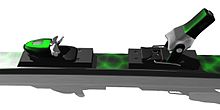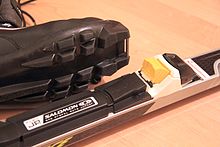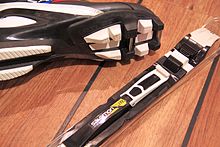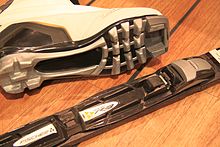Ski binding
A ski binding is the part of a ski that connects the ski boot to the ski. Depending on the ski, there are many different ski bindings, which are mainly characterized by different ways of attaching the boot to the ski. In Nordic skiing (for example, cross-country skiing) and telemarking, the boot is attached to the ski only by the tip of the boot, while the heel remains free; in alpine skiing, on the other hand, both the tip of the boot and the heel are attached to the ski.
In addition to connecting the boot to the ski, the ski binding ensures the correct transmission of power from the foot to the ski, especially in alpine skiing, which is important for the sensitive control of the ski. The ski binding is also essential for the safety of the athlete, which is why an alpine ski binding is often also called a safety binding. A safety binding connects the boot to the ski until a certain limit of force is exceeded. At higher loads, the binding releases and the ski separates from the boot. If the release value is set correctly according to the skiing ability and the maximum load of the athlete, injuries caused by bulky skis on the feet can be avoided in the event of a fall (see also: Ski accident).
In cross-country skiing, three incompatible binding systems are available in German-speaking countries: SNS (Salomon Nordic System) Profile, SNS Pilot and NNN (New Nordic System). While with SNS Profil and NNN the boot is held flexibly on the binding with a metal axle, with SNS Pilot a second metal axle in the boot and an associated metal rail provide increased lateral stability (especially in the skating style).
In carving skis, a plate (damping plate, elevation plate) is often mounted between the ski and the binding. Newer ski designs, especially the cap design, allow ski manufacturers to integrate the binding system directly into the ski. For sports retailers, this makes assembly easier, but for consumers, integrated binding systems also bring disadvantages, since used bindings can no longer be mounted on newly purchased skis.
For touring skis there is a special combination of safety and Nordic binding, the touring binding. It fixes only the toe of the boot for the ascent, while the heel remains free. For the descent, the heel can be fixed. Many modern touring bindings, especially the so-called freeride models, meet the requirements of piste-suitable safety bindings.
So-called Vario ski bindings allow the heel and front automatic to be moved quickly in order to either quickly adapt the binding to a different ski boot or to move the ski boot on the ski in order to achieve a different centre of gravity position, for example.
Ski bindings, ski boots and the procedure for correctly adjusting a safety binding are standardized according to various international standards (e.g. ISO 11088).
In skiing, a false release is the automatic opening of the binding in a situation in which this is not desired. False releases can be caused on the one hand by a too soft setting of the binding, but also by repeated blows on the ski if the setting is correct. If strong blows are repeated on the ski in a very short time, the binding cannot recalibrate completely, so that the next blow causes the binding to pop open, the false release.

Downhill ski binding

The SNS profile cross-country binding has a metal axle that locks into the binding.

The SNS Pilot binding uses a second metal axle in the boot for a tension spring (white) for stabilization.

The NNN binding has no middle bar, but two side bars.
See also
- Snowboard binding
- Cross country ski#binding, description of the binding systems NN, SNS Profile, SNS Pilot, NNN for cross country skiing
- Telemark#Binding
Search within the encyclopedia